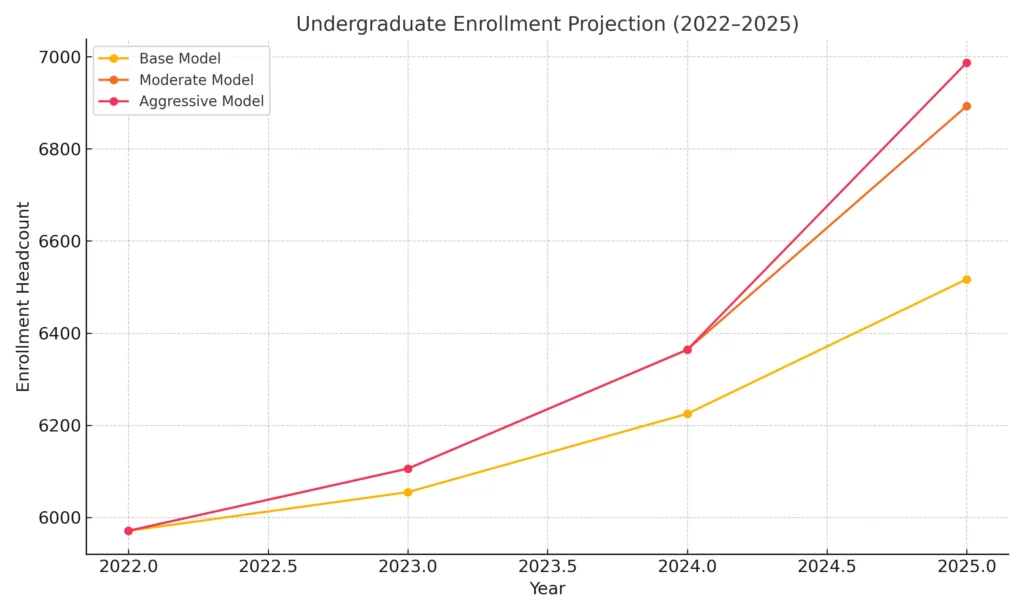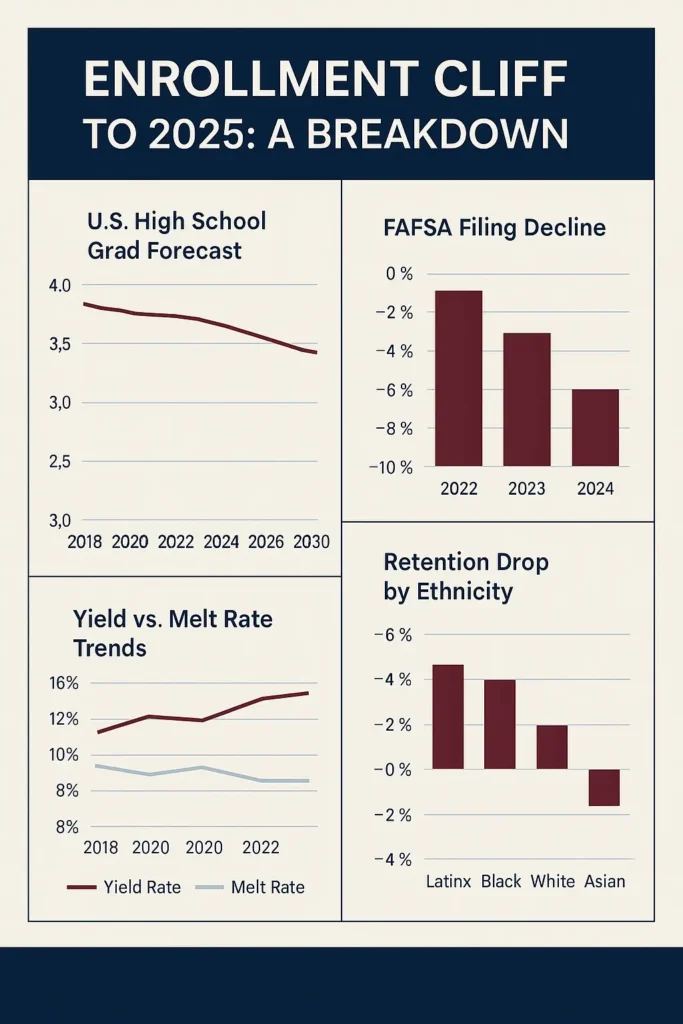Colleges and universities can no longer afford to treat enrollment management as a segmented task. The year 2025 marks a turning point—declining high school graduation rates, FAFSA processing failures, and shifting learner preferences are converging into a true enrollment crisis. Yet many institutions are still operating from pre-pandemic playbooks.
An Integrated Strategic Enrollment Plan (ISEP) isn’t just a document; it’s a cross-functional roadmap that connects recruitment, retention, finance, and academic programming into a single strategy. For higher ed leaders aiming for long-term sustainability, this year’s planning cycle demands a sharper lens and updated assumptions.

Stop Relying on Pre-2020 Baselines
Many colleges continue to set growth targets based on enrollment data from 2018 to 2020, assuming those numbers still reflect current conditions. But the landscape has shifted dramatically. The FAFSA simplification delays alone caused a 30% drop in submissions nationwide as of spring 2024, fundamentally altering the pipeline. Planning around outdated benchmarks not only distorts projections but also leads to serious missteps in resource allocation and institutional strategy.

Instead, institutions must rebuild their Integrated Strategic Enrollment Plans (ISEPs) around actual performance data for 2023 and 2024. That includes revisiting all headcount assumptions and adjusting for current trends in applications, financial aid completions, and student retention. For example, the University of San Francisco’s 2022 plan projected 7,127 undergraduates by 2025 under a moderate growth model. In reality, that figure now trends closer to 6,500 due to ongoing demographic shifts and yield volatility.
To stay grounded in today’s realities, leaders must replace legacy growth charts with dynamic projections that reflect their own CRM data, program-level melt rates, and evolving enrollment behavior. At Accreditation Expert Consulting, we guide institutions through this recalibration process—using live CRM exports and scenario-based modeling with academic and operational stakeholders to generate accurate, sustainable plans. Learn more
Address the Hidden Gaps: Retention, Not Just Recruitment
At many institutions, strategic enrollment planning still centers almost entirely on recruitment, getting students in the door. But in our work with colleges and universities, a quieter, often overlooked issue consistently emerges: retention. The real challenge is not just how many students enroll, but how many persist beyond the first year, especially into the critical second and third years. For example, at the University of San Francisco, the second-to-third-year retention rate for the 2019 cohort dropped to 70.2%, revealing a significant gap in enrollment throughput. This issue is even more pronounced among Latinx and Black students, who now represent a growing share of the student population but continue to experience lower long-term retention when support structures are weak or fragmented.
Rather than treating this as a student services issue alone, institutions must treat retention as a central component of their Integrated Strategic Enrollment Plan (ISEP). This means incorporating realistic attrition models and embedding student success interventions directly into the core strategy, rather than as add-ons. Aligning academic advising, course scheduling, and program design with the actual needs and experiences of today’s students isn’t just a support tactic; it’s a financial strategy. When colleges retain more of the students they’ve already enrolled, they reduce recruitment pressure, improve budget stability, and deliver stronger outcomes across the board.
Redesign Your Program Mix for the 2025 Learner
Across the country, prospective students are becoming more skeptical about the return on investment of traditional degrees—and frankly, they have good reason. Undergraduate students are increasingly debt-averse, and graduate students are demanding programs that are faster, more flexible, and directly tied to career advancement. This shift is reshaping what prospective learners expect and what they’re willing to pay for.
The enrollment data confirms it. According to IPEDS, post-baccalaureate certificate enrollments rose by 12% between 2022 and 2024, while full-time master’s enrollment has declined in several non-STEM disciplines. In parallel, hybrid and online program formats have surged, now making up over 45% of new adult learner enrollments in certain regions. The trend is clear: students want options that are modular, adaptable, and aligned with real labor market outcomes.
For provosts and deans, this presents both a challenge and an opportunity. Rather than allowing legacy programs to define future strategy, institutional leaders should use their Integrated Strategic Enrollment Plan (ISEP) to spark intentional internal dialogue around which programs to grow, reformat, or sunset. Focusing on short-cycle, stackable credentials—particularly in areas like healthcare, compliance, data, and leadership—can help institutions meet demand while staying true to their mission. At Accreditation Expert Consulting, we facilitate these conversations through faculty-driven workshops that combine labor market analytics with mission-fit scoring rubrics, ensuring that new program development is both strategic and sustainable.

Fix the Front-End Funnel, But Only with Real Strategy
When enrollment numbers dip, many institutions instinctively respond by increasing lead generation—buying more names, ramping up digital ads, or outsourcing to third-party recruiters. But lead volume isn’t the same as enrollment strategy. Without a clear process to nurture and convert those leads, most of that investment goes to waste. We’ve seen this repeatedly in our consulting work: institutions are spending more to fill the top of the funnel, while the yield process underneath remains fractured or outdated.

An effective Integrated Strategic Enrollment Plan (ISEP) addresses this by going deeper than surface-level marketing tactics. It links campaign performance with downstream elements, financial aid responsiveness, CRM workflows, communications for admitted students, and access to live support from advisors. In many cases, we uncover critical gaps, like admitted students not receiving personalized cost breakdowns until just before census, undermining their decision-making and confidence.
To make real progress, enrollment teams need to rebuild the yield journey from admit to day one. Start small: choose one student segment, such as first-generation commuter students, and walk through every step of their communication experience. Financial aid notifications, housing options, and registration access aren’t peripheral touchpoints. They’re central to the student’s decision to show up, enroll, and persist.
FAFSA Filing Crisis
In 2024, FAFSA simplification resulted in a 30%+ national drop in completed applications. This single factor caused thousands of students, especially from low-income households, to miss priority deadlines or defer enrollment altogether. If your 2025 ISEP doesn’t factor in FAFSA recovery strategies, you’re planning in the dark.
Bring Academic Leadership into the Room

Too often, Integrated Strategic Enrollment Plans (ISEPs) are developed almost entirely within the enrollment or SEM office, with minimal involvement from provosts, deans, or department chairs. This disconnect leads to ambitious enrollment goals that aren’t grounded in academic capacity, scheduling realities, or the evolving relevance of program offerings. When academic leadership isn’t engaged from the start, institutions risk overpromising on programs they can’t deliver or missing opportunities to adjust curriculum in ways that support student retention.
To be truly effective, academic leaders must share ownership of the ISEP. That means more than just approving course schedules. It involves co-developing new program ideas, aligning course sequencing with projected enrollment shifts, and embedding retention strategies into instruction and policy. We’ve found that when faculty are brought into the process through structured workshops and asked to co-author enrollment impact statements, the result is not only greater buy-in, but smarter, more responsive planning across departments.
Now Is the Time to Rebuild, Not Recycle
At Accreditation Expert Consulting, we work with colleges and universities across the U.S. to develop ISEPs that are effective, grounded in real data, and informed by cross-functional strategy and practical timelines. Whether you’re starting from scratch or trying to fix a fragmented approach, the right plan can become a real tool for stability.
Want to test if your ISEP is ready for 2025?
Run a one-hour gap analysis with your leadership team. If you find more questions than answers, it’s time to rebuild.




